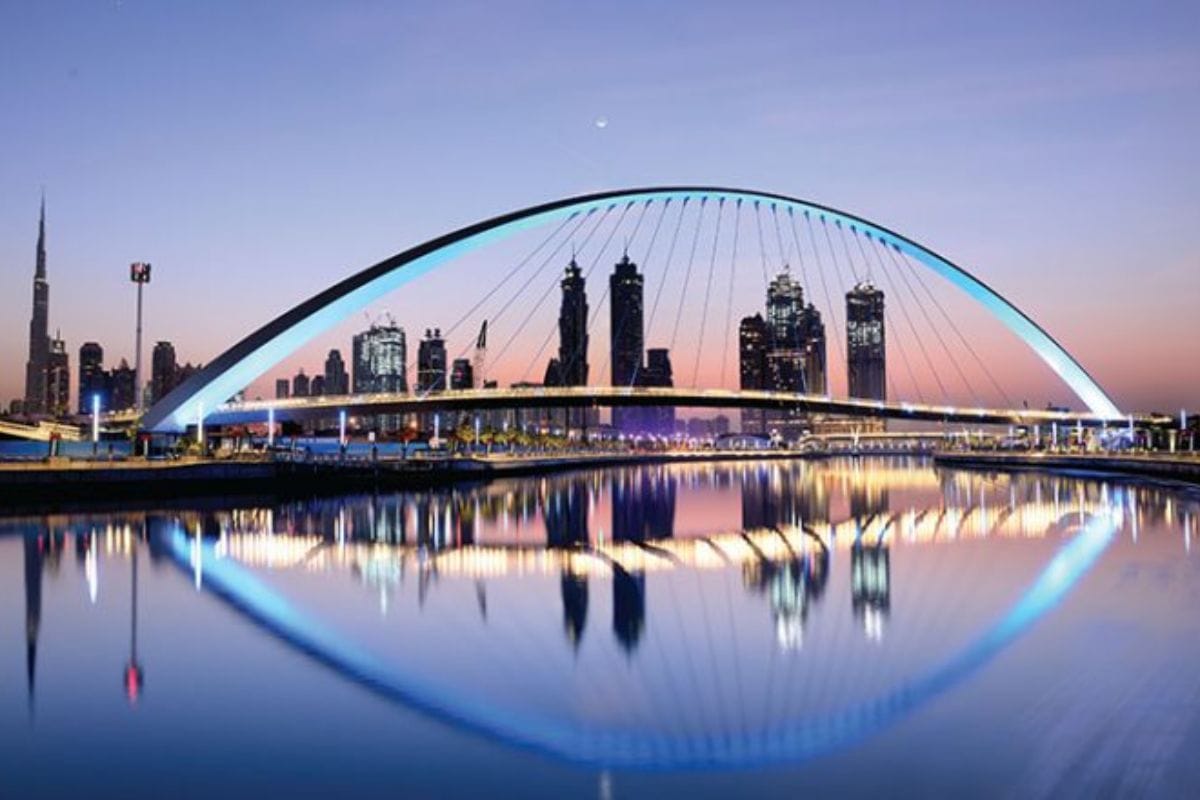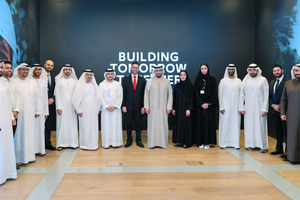Dubai transforms when the sun sets. Its skyline, already remarkable during the day, takes on a new personality as lights bring its landmarks to life. When night falls, light takes center stage, reshaping how we experience its iconic landmarks. Beyond the functional purpose of illumination, lighting in Dubai has evolved into an art form; a medium that breathes life into architecture, evokes emotions, and creates lasting impressions.
There’s a psychology behind how light impacts the human experience. Warm tones create comfort and nostalgia, while dynamic patterns excite and inspire. Dubai’s architects and lighting designers understand this deeply, using light to showcase structures and tell stories. From subtle highlights that accentuate intricate details to bold displays that dominate the skyline, every beam serves a purpose.
Take a moment to imagine walking along the Dubai Water Canal, where the bridge’s vibrant hues ripple across the water, or standing in front of the Burj Khalifa as it transforms into a canvas of light and motion. These are more than visual spectacles; they’re carefully crafted experiences connecting people to the city and its identity.
In this article, we’ll uncover how Dubai has mastered the art of lighting, delving into the psychological effects, innovative technologies, and captivating stories told through its illuminated landmarks. This is the story of how light, when used intentionally, can redefine a city’s soul.
The Emotional Impact of Light
Lighting is far more than a practical necessity; it plays a significant role in shaping emotions and perceptions. In Dubai, the strategic use of light turns architecture into an experience. Warm colours like gold and amber create a sense of comfort and opulence, often seen in landmarks such as Atlantis The Palm and the Dubai Frame. These tones invite people to pause and discreetly connect with their surroundings, even amidst grandeur.

Cooler shades, such as blues and whites, bring a sense of tranquillity and modernity. The Dubai Water Canal, for instance, reflects clean white lights onto its shimmering waters, creating a calm and peaceful atmosphere. At the Burj Khalifa, bold, colourful LED patterns energize viewers and add a sense of wonder, making the building feel alive with movement.
Research shows that light affects human psychology in profound ways. Bright, vibrant lighting can energize and inspire, while softer, more focused light draws attention to intricate details. This is evident in the Museum of the Future, where lighting highlights the Arabic calligraphy that adorns its reflective exterior. The interplay of light and shadow invites viewers to reflect on the meaning and artistry of the structure.
In Dubai, lighting is used to evoke emotions, guide attention, and transform spaces into meaningful experiences. Every beam and shade is thoughtfully planned to engage the senses and leave a lasting impression.
The Role of LED Lighting in Dubai's Architectural Evolution
Dubai’s skyline has been transformed by the integration of LED technology. These advanced systems offer a level of flexibility and precision that traditional lighting could never achieve. Designers can create intricate displays and dynamic colour schemes, giving each landmark its own unique identity.
Take the Burj Khalifa, for instance. Its LED panels illuminate more than the night; they celebrate cultural milestones and tell visual stories that resonate with people. From national flags to artistic designs, the displays turn the tower into a focal point of celebration and connection.
Beyond their visual appeal, LED lights are also an environmentally responsible choice. Consuming far less energy than conventional lighting, they contribute to Dubai’s sustainability goals. Projects like the Dubai Lamp initiative, which introduced some of the world’s most energy-efficient bulbs, reflect the city’s commitment to innovation and environmental stewardship.

LEDs also enhance the architectural design of spaces. The Museum of the Future, with its curved reflective facade, uses LED lighting to create depth and movement, adding a futuristic edge to its already striking appearance. This ability to blend form and function has made LED lighting an essential part of Dubai’s evolving skyline.
Through these innovations, LED lighting has become more than a technological upgrade; it’s an integral part of how Dubai expresses its character and ambition.
Iconic Landmarks and Their Illuminating Stories
Lighting has a transformative power, and in Dubai, it turns architectural marvels into immersive experiences. Each landmark uses light to captivate viewers, blending design and storytelling to create moments that linger in memory.
Burj Khalifa

The Burj Khalifa stands as a global icon, not only for its towering height but also for its mesmerizing light shows. Its LED displays transform the building into a vibrant canvas, celebrating cultural events, global milestones, and festive occasions. From intricate patterns to national flags, the visual displays make the Burj a beacon of celebration that unites people.
Museum of the Future
The Museum of the Future showcases the fusion of cutting-edge architecture and thoughtful lighting design. Its reflective facade, adorned with Arabic calligraphy, comes alive at night through carefully placed lights. The illumination emphasizes the building's futuristic theme, inviting visitors to contemplate innovation and discovery.
Dubai Frame
Symbolizing the connection between Dubai’s past and future, the Dubai Frame glows with a golden hue that reflects the city’s heritage. At night, the lighting accentuates its clean lines, creating a visual link between the old and the new. The soft, golden tones evoke a sense of nostalgia and pride.
The Palm Fountain at The Pointe

Recognized as the world’s largest fountain, The Palm Fountain is a spectacle of light, water, and music. Its vibrant LED displays synchronize with water jets to create dynamic performances that captivate audiences. The lively lighting transforms the fountain into an entertainment hub, attracting visitors from all over the world.
Global Village
At Global Village, lighting takes on a cultural narrative. Each pavilion features colors and designs that represent its respective country, creating a vibrant mosaic of global diversity. The warm, inviting lights turn the village into a festive celebration of unity and culture.
These landmarks demonstrate how Dubai uses lighting to go beyond aesthetics. It’s about creating connections, evoking emotions, and turning the city’s skyline into a living, breathing masterpiece.
The Science Behind Captivating Lighting Displays
The magic of Dubai’s lighting isn’t random; it’s rooted in science and psychology. Every colour, intensity, and pattern is carefully chosen to guide emotions and perceptions, making landmarks not just visually stunning but emotionally engaging.
Emotional Engagement Through Color
Colours evoke feelings, and lighting designers in Dubai understand this deeply. Warm hues like gold and amber create a sense of comfort, luxury, and nostalgia, often used in places like the Dubai Frame and Burj Al Arab. Cooler tones, such as blue and white, evoke tranquillity and sophistication, as seen in the Dubai Water Canal. The careful use of colour ensures that each landmark tells a story while eliciting a specific emotional response.
Visual Hierarchy: Guiding Attention
Lighting in Dubai’s architecture doesn’t merely illuminate—it directs focus. Techniques like spotlighting are used to highlight key features, such as the Arabic calligraphy on the Museum of the Future. Meanwhile, gradient lighting on structures like the Burj Khalifa draws the eye upward, emphasizing its towering height. This strategic placement ensures that every viewer’s gaze is guided to what matters most.
Dynamic Movement: The Appeal of Animation
Human brains are naturally drawn to motion, and Dubai’s landmarks leverage this with dynamic lighting displays. The synchronized lights of The Palm Fountain, for instance, captivate audiences with their rhythmic patterns and seamless choreography. The Burj Khalifa’s LED panels similarly use animated sequences to create a sense of movement, making the structure feel alive.
Cultural Context and Symbolism

Lighting in Dubai often goes beyond aesthetics to incorporate cultural symbolism. The golden glow of the Dubai Frame represents the city’s heritage, while festive displays on the Burj Khalifa celebrate global events, from New Year’s Eve to National Days. This thoughtful approach ensures that lighting resonates on a deeper, more personal level with viewers.
By combining science, psychology, and artistry, Dubai’s lighting designers have created experiences that are not only visually captivating but also deeply memorable. It’s this blend of technique and storytelling that makes the city’s lightscapes so unique.
Dubai’s use of lighting transforms its skyline into an experience that lingers in memory. From the glow of its landmarks to the thought behind each display, light here is more than practical; it’s intentional, inspiring, and unforgettable.
Also Read:

















